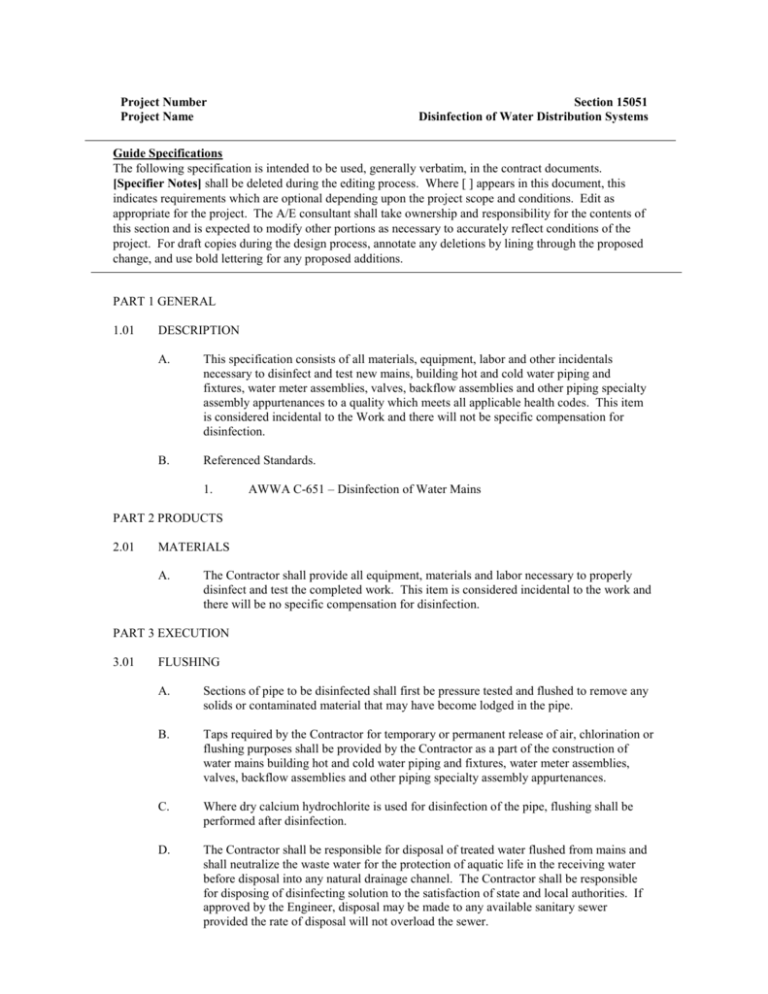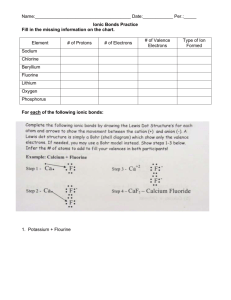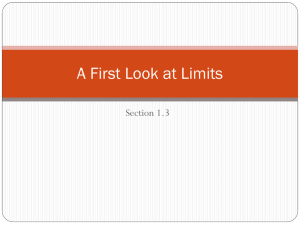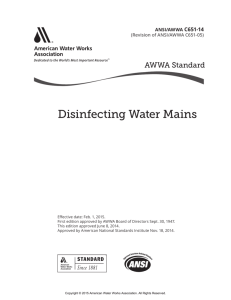Disinfection of Water Distribution Systems
advertisement

Project Number Project Name Section 15051 Disinfection of Water Distribution Systems Guide Specifications The following specification is intended to be used, generally verbatim, in the contract documents. [Specifier Notes] shall be deleted during the editing process. Where [ ] appears in this document, this indicates requirements which are optional depending upon the project scope and conditions. Edit as appropriate for the project. The A/E consultant shall take ownership and responsibility for the contents of this section and is expected to modify other portions as necessary to accurately reflect conditions of the project. For draft copies during the design process, annotate any deletions by lining through the proposed change, and use bold lettering for any proposed additions. PART 1 GENERAL 1.01 DESCRIPTION A. This specification consists of all materials, equipment, labor and other incidentals necessary to disinfect and test new mains, building hot and cold water piping and fixtures, water meter assemblies, valves, backflow assemblies and other piping specialty assembly appurtenances to a quality which meets all applicable health codes. This item is considered incidental to the Work and there will not be specific compensation for disinfection. B. Referenced Standards. 1. AWWA C-651 – Disinfection of Water Mains PART 2 PRODUCTS 2.01 MATERIALS A. The Contractor shall provide all equipment, materials and labor necessary to properly disinfect and test the completed work. This item is considered incidental to the work and there will be no specific compensation for disinfection. PART 3 EXECUTION 3.01 FLUSHING A. Sections of pipe to be disinfected shall first be pressure tested and flushed to remove any solids or contaminated material that may have become lodged in the pipe. B. Taps required by the Contractor for temporary or permanent release of air, chlorination or flushing purposes shall be provided by the Contractor as a part of the construction of water mains building hot and cold water piping and fixtures, water meter assemblies, valves, backflow assemblies and other piping specialty assembly appurtenances. C. Where dry calcium hydrochlorite is used for disinfection of the pipe, flushing shall be performed after disinfection. D. The Contractor shall be responsible for disposal of treated water flushed from mains and shall neutralize the waste water for the protection of aquatic life in the receiving water before disposal into any natural drainage channel. The Contractor shall be responsible for disposing of disinfecting solution to the satisfaction of state and local authorities. If approved by the Engineer, disposal may be made to any available sanitary sewer provided the rate of disposal will not overload the sewer. 3.02 REQUIREMENT OF CHLORINE A. 3.03 Before being placed into service, all new mains and repaired portions of, or extensions to, existing mains shall be chlorinated so that a chlorine residual of not less than 25 mg/l remains in the water after standing 24 hours in the pipe. The initial chlorine content of the water shall be not less than 50 mg/l. FORM OF APPLIED CHLORINE A. Chlorine shall be applied by one of the methods which follow to give a dosage of not less than 50 mg/l of available chorine 1. Dry Calcium Hypochlorite a. b. 2. Liquid Chorine a. 3. A mixture of water and high-test calcium hypochlorite (65 – 70% Cl) may be substituted for the chlorine gas-water mixture. The dry powder shall first be mixed as a paste and then thinned to a 1 percent chlorine solution by adding water to give a total quantity of 7.8 gallons of water per pound of dry powder. This solution shall be injected in one end of the section of main to be disinfected while filling the main with water. Sodium Hypochlorite a. 3.04 A chlorine gas-water mixture shall be applied by means of a solutionfeed chlorinating device, or the dry gas may be fed directly through proper devices for regulating the rate of flow and providing effective diffusion of the gas into the water within the pipe being treated. Chlorinating devices for feeding solutions of the chlorine gas, or the gas itself, must provide means for preventing the backflow of water into the chlorine. Chorine-Bearing Compounds in Water a. 4. As each length of pipe is laid, sufficient high test calcium hypochlorite (65 – 70% chlorine) shall be placed in the pipe to yield a dosage of not less than 50 mg/l available chlorine, calculated on the volume of the water which the pipe and appurtenances will contain. The number of ounces of 65% test calcium hypochlorite required for a 20-foot length of pipe equals 0.00843 l x d in which “d” is the diameter in inches. Sodium hypochlorite, commercial grade (12.5% Cl) or in the form of liquid household bleach (5 – 6% Cl) may be substituted for the chlorine gas-water mixture. This liquid chlorine compound may be used full strength or diluted with water and injected into the main in correct proportion to the fill water so that dosage applied to the water will be at least 50 mg/l. POINT OF APPLICATION A. The preferred point of application of the chlorinating agent is at the beginning of the pipeline extension or any valved section of it, and through a corporation stop inserted in the horizontal axis of the pipe. The water injector for delivering the chlorine-bearing water into the pipe should be supplied from a tap on the pressure side of the valve controlling the flow into the pipeline extension. Alternate points of applications may be used when approved by the Engineer. 3.05 RATE OF APPLICATION A. 3.06 PREVENTING REVERSE FLOW A. 3.07 In the process of chlorinating newly-laid pipe, all valves, hydrants, and/or other appurtenances shall be operated while the pipeline is filled with the chlorinating agent and under normal operating pressure. CHLORINATING CONNECTIONS TO EXISTING WATER MAINS AND WATER SERVICE CONNECTIONS A. 3.11 Treated water shall be retained in the pipe at least 24 hours. After this period, the chlorine residual at pipe extremities and at other representative points shall less than 25 mg/l. CHLORINATING VALVES, HYDRANTS AND APPURTENANCES A. 3.10 No connections shall be made between the existing distribution system and pipelines not disinfected under this Contract without a Washington State Department of Health approved backflow preventer installed in the connecting line. RETENTION PERIOD A. 3.09 Water from the existing distribution system, or other source of supply, shall be controlled to flow very slowly into the newly-laid pipeline during application of the chlorine. The rate of chlorine gas-water mixture or dry gas feed shall be in such proportion to the rate of water entering the newly-laid pipe that the dosage applied to the water will be at least 50 mg/l. The chlorinating procedure to be followed shall be as specified in AWWA Standard C651. All closure fittings shall be swabbed with a very strong chlorine solution at least as strong as liquid household bleach (5 – 6 % Cl). FINAL FLUSHING AND TESTING A. Following chlorination, all treated water shall be flushed from the newly-laid pipe until the replacement water throughout its length shows, upon test, the absence of chlorine. A sample tap shall be located ahead of the flushing hose for convenience and for sanitary sampling. Prior to flushing, the Contractor shall collect a water sample and deliver it to the City of Cheney Wastewater Treatment Plant for analysis as well as provide the City of Cheney with an estimated quantity of effluent to be discharged during the final flushing operations. The City of Cheney will provide approval of quantity and quality of final flushing effluent to be discharged to the sewer system. The Contractor shall notify the City of Cheney when the discharge shall be released. Coordinate the discharge point with the Owner. B. Before placing the lines into service, a satisfactory sample test report shall be received from the local or State Health Department on samples collected from representative points in the new system. Samples will be collected and bacteriological tests obtained by the Contractor with the results submitted to the A/E and Owner’s Representative prior to returning the water system to service. C. Residual Chlorine Level: The Contractor shall final flush the completed water system Work after a satisfactory health department bacteriological test, to reduce the residual free chlorine level to less than or equal 0.02 ppm. A water sample shall be taken by the Contractor to verify the residual chlorine level. If the residual chorine level exceeds the 0.02 ppm limit, the Contractor shall continue final flushing and testing the residual chorine level at no additional cost to the Owner until results are obtained to the satisfaction of the Owner. 3.12 REPETITION OF FLUSHING AND TESTING A. Should the initial treatment result in an unsatisfactory bacteriological test, the Contractor shall repeat the original chlorination procedure until satisfactory results are obtained. Failure to obtain a satisfactory test results shall be considered a failure of the Contractor to keep the pipe clean during construction, or properly chlorinate the main. END OF SECTION 15051







